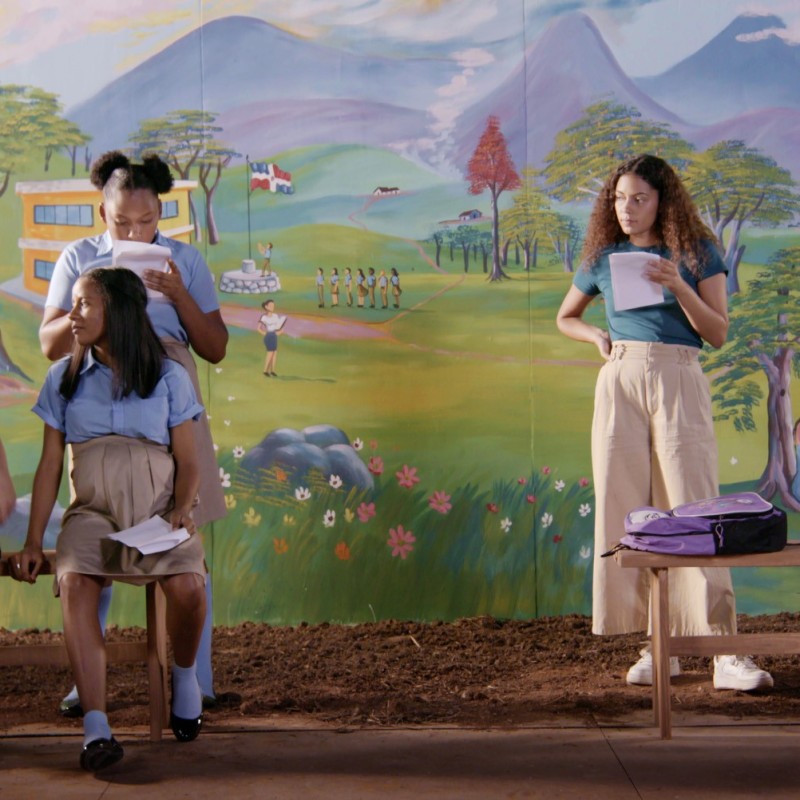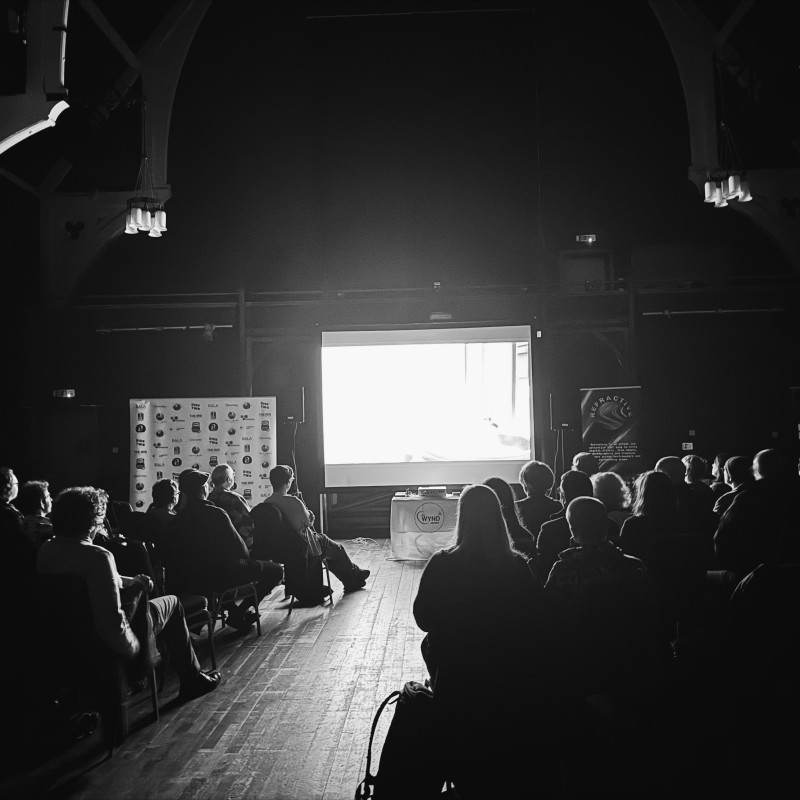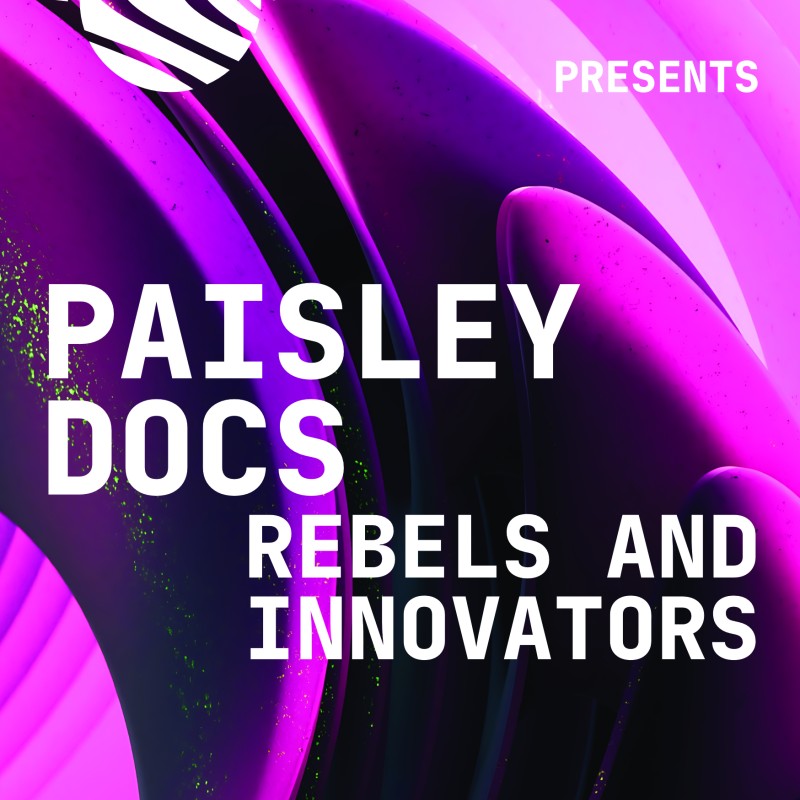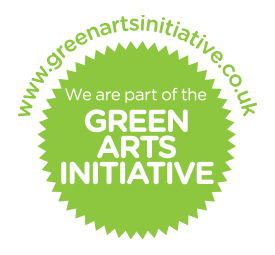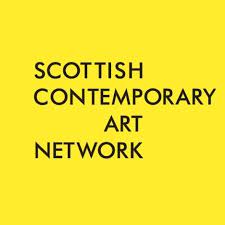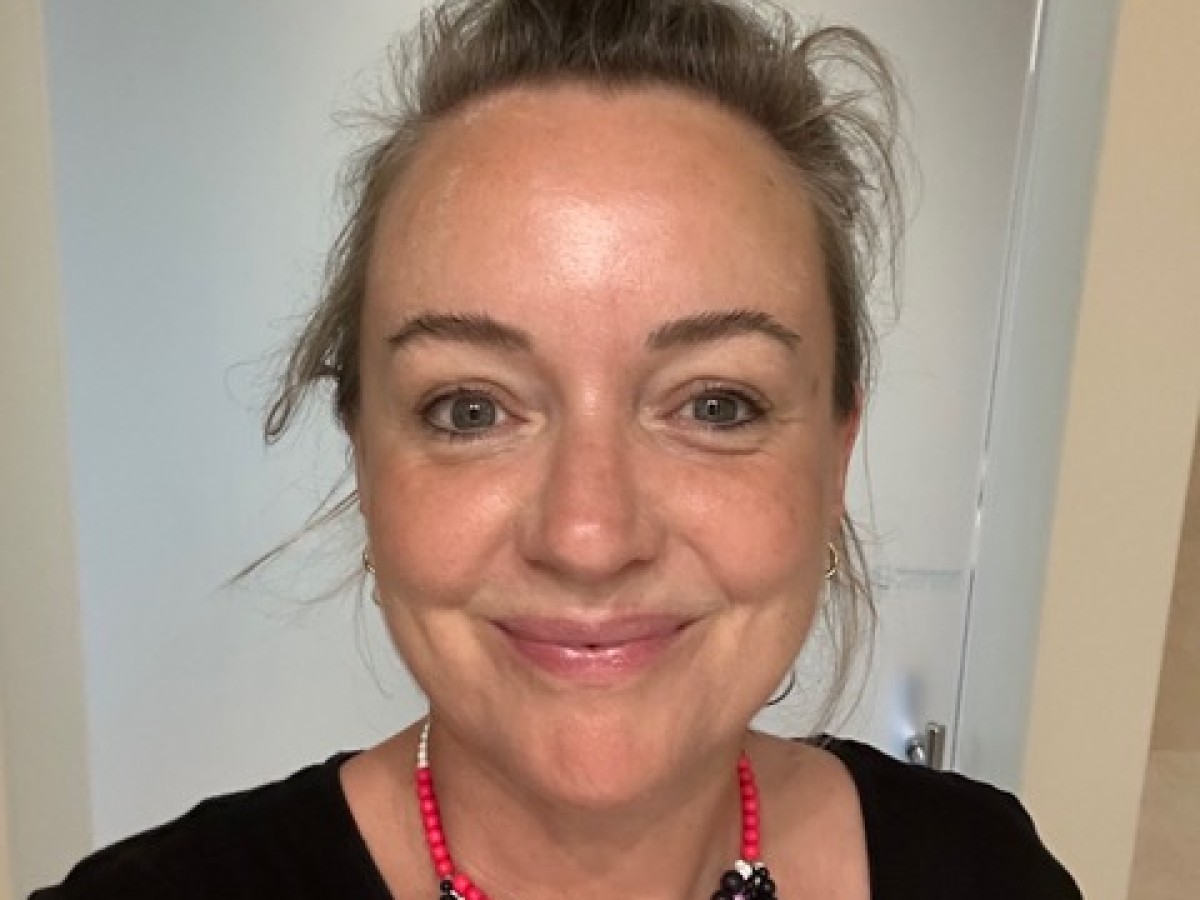
As part of our Paisley Docs: Rebels and Innovators programme, we spoke to filmmaker and artist Samantha Moore about her approach to animated documentary.
Samantha is a filmmaker with an interest in collaborative animation practice looking at hidden and overlooked stories and communities, especially those marginalised by gender, age, socio-economic status, visual accessibility, and geography.
Samantha has worked with a variety of groups and communities, from lingerie machinists to microbiologists, and always encourages collaborators to claim space inside the frame. Her films have ranged from exploring competitive sweet pea growing, to archaeology, neuroscience, HIV/AIDs, and her own experience of having twins.
Samantha’s work has won several accolades, including being nominated for a BAFTA (2024), featured in the New York Times (26/12/23), two awards from the science journal Nature (2010, 2016), two Vimeo Staff Picks (2020, 2024), the Best British Film at the London International Animation Festival (2019), The Director’s Prize at Athens Video + Film Festival (2024) and nominations for three biennial British Animation Awards (2004, 2020, 2024).
Samantha’s 2023 film Visible Mending will be shown at Johnstone Textile Space on Saturday 11th of October, you can book your tickets here. Keep your eyes peeled for Bloomers in the second half of Paisley Docs: Rebels and Innovators which will be coming very soon!

(Still from Visible Mending).
Interview
How did you get into filmmaking?
I did my degree in English and Art, and started off as a painter. I was really interested in telling stories and drawing pictures so one of my tutors suggested I put my paintings under the camera and that was how I discovered oil on glass animation. Oil paint takes ages to dry, so you can move it around for days actually as long as you kind of keep it warm. I was inspired by Lizzie Hobbs, an animator who studied in Scotland and does beautiful animations.
But then I had twin sons, and when I got pregnant with them, I wanted to carry on filmmaking, but I couldn’t do oil on glass because it just wasn’t very conducive to breastfeeding. And so I taught myself digital animation.
I’ve always been interested in working with real stories, I don’t really know why, but there’s just something about that tension between reality and fantasy that I find really fascinating. When I was studying English literature, I really liked magic realism because of that lovely clunky pragmatic realism alongside a beautiful flight of fancy that I just think has got something special about it.
That actually leads really well into my next question. What is it that appeals to you about using animation as a form of documentary filmmaking?
Mm, I think because it tells a different kind of truth, you know. If you use a camera to make a photographic image of something, obviously that captures something really special. But there’s something around animation, where you are sourcing your images somewhere different and it kind of can tell different sorts of truths.
I think there are some stories which are maybe more interestingly told or just more completely told through using animation than they are from using live action filmmaking. And although it might seem a bit counterintuitive, actually, animation can bring something really special to it. I think there’s something around the internal that animation can bring something to in a documentary.
Yeah, that’s amazing. That is very much something I sort of picked up on in Visible Mending, the animation just added a different dimension to the discussions of the interviewees. Thank you for sharing that insight! So, you have kind of touched on this, but what is it that inspires your work?
Um, I don’t know. Lots of things! I mean, like most artists, I keep a sketchbook and I always have several ideas for films I want to make. If you gave me a hundred thousand pounds today, I’d be very happy and I’d immediately have a project I could work on. So I think I just kind of look for projects, which can be told.
The animation can bring something too. I think there’s lots of things you can do with animated documentaries, but just because you can do them, you don’t have to do them. So then some projects, you have to do them with animated documentaries because there’s no other real way of telling them. You are bringing something so specific to the story through using animation that it is going to take your audience to a different place.
I do think animation has a special place in people’s hearts and a lot of people really love animation, they’re obsessed with it. Or there are a lot of people that are quite fond of it and think it’s for children. Whether they’re obsessed or whether they just think it’s kind of fairly benign, I think there is a sense of animation being a happy place for people or it is somewhere they feel safe and maybe not as challenged as they do in other kinds of filmmaking.
So that allows you to do something with animation, I sort of smuggle in ideas in a way. I always talk about the Trojan Horse of animation because you know people welcome it. “Oh, animation. I love animation. Yeah. Show me your film”, and then you show them a film and it’s about AIDS and HIV and Uganda, and they’re like “Oh shit”. But then its kind of too late, you’ve already smuggled something in under their defenses and they can open up their hearts, brains and ideas to different things which maybe if you’d have said I’m gonna show you a very serious documentary about HIV and Aids in Uganda they’d be like “Oh, I don’t think so, I think I might watch something else”. So I think that’s what I think animation does, and I think it’s a really precious thing that we can do.
Absolutely, sometimes it’s just about trying to get people to bear with you with a documentary. I love the idea of the Trojan Horse of Filmmaking! Do you mind talking a bit about your process? How do you go about making films?
I always take a very research based perspective. Especially when thinking about how animated documentaries can represent the internal. I did a PhD at Loughborough University about using animation to represent internal brain states like synesthesia, phantom limb syndrome and face blindness, which is called prosoagnosia. All of those things are really internally experienced, but they’re also quite well studied and there are lots of papers written about them. I’ve also worked with microbiologists at Imperial College London, London School of Hygiene and Tropical Medicine. Because it’s such a different area to my own area of study, the first thing I do is just loads of reading, because some of it is about talking to a lot of gatekeepers who you need to know how to get through in order to meet some other people who will be helpful to your project. And quite often you need a certain set of vocabulary to talk to them or else they just brush you off, you know? Yeah. So I do find that learning the language of the area that you’re moving into is super important. And just understanding the terminology and some of the key material that’s been written around that. Then you are obviously not going in from any kind of expert position, but you’re going in as a semi knowledgeable, amateur, and you can hold your own.
Then once that’s done, I will always start with the audio, and I have quite a convoluted interview recipe that I use. I meet people maybe one or two times before I even start audio recording because I think there’s something around that connection that you get from people that sometimes needs a run up and base to build a relationship on. It is really important when you’re taking someone’s story that you are respectful and ethical in the way you deal with it. And ensure that they have signed all their consent forms, that they understand what the project is, and they understand what it is they are giving to you. Because I think quite often people are really keen to tell their stories. But you think I’m gonna take it and I’m gonna show it to a lot of people. A lot of people are gonna hear things which you might not have told anybody else or you might feel embarrassed to have said. Therefore I just need to be really careful of what I’m taking from interviewees and making sure they have an understanding of that. So yeah, that’s how my process starts, I would say.
That’s really interesting. So we are going to be showing Visible Mending and Bloomers, but do you have a favourite film that you’ve made?
Oh no. I think, you’ll know this as an artist, you simultaneously love and loathe everything you’ve ever made. You know, it’s like a photo of yourself. You’re just like, yeah, but no. Every time you look at it you can see more problems. I’ve definitely got films that I’m really proud of and represent something really important and I’m really happy to have made them. But I don’t think there’s a single film that I wouldn’t make again if you gave me the opportunity. Just let me have one more go and I can totally know this time I can, I can do this.
Yeah. I always love it when you look back at a piece of work and you’re like, oh, I would totally do that differently, but I do know why I did it that way.
Exactly. And I think there’s also a thing as well, if you have enough distance between you and the piece of work then you are able to look at it with affection. If not exactly love, you can kind of look back at it and go, “Oh, look at her, she was really trying her best with that one!” you know? And I also think that the impulse to make comes from never making something that feels quite right. If you made something perfect, you’d be like “right, I’m giving up, I’m never doing another film ’cause I’ve already done it”. As a result, there’s always another film I wanna make.
I mean, not that I don’t think your work’s perfect. I think it is perfect, but I’m very glad that you’re continuing to make films because I love your work! So, the final question I have is, do you have any advice for filmmakers or artists looking to approach using animation in documentaries?
Yeah, animation is an incredibly slow process, so never underestimate how long it’s gonna take you. I think, and joking aside, that’s kind of a key point. I wouldn’t ever call someone I work with a subject, like a subject in my film, I’d call them an interviewee or a collaborative consultant because I really like to keep that relationship going. I talk to them throughout the process of the filmmaking. With Visible Mending I would send out a newsletter of what was happening throughout the filmmaking process to keep the group of collaborators I was working with.
More advice I would give is follow your nose. Do the things you know, if you’re going to do a project that is gonna take you so long you need to know and like it. Visible Mending took five years in total from beginning to end, and it started with no or a very, very small amount of funding and just me just thinking, I really wanna do this. So if you’re gonna start with a project like that, then you just need to really love it because if you fall out of love halfway through, oh my god, no, don’t do that. Follow your instincts and your passions. I also think it kind of comes back to being really aware that when you work with documentary you’re working with other people’s stories, not just your own. It’s important to be respectful of that and to remain aware that your collaborators’ experience of the process is going to be quite different to yours.
But yeah, I mean, I just think animation directors are kind of self-selecting lunatics. I dunno, we are kind of the geologists of the film world. All kinds of timescales are totally different from anybody else’s. It takes like a thousand years to make this tiny groove in this rock. I’m probably not making much sense.
No, it’s perfect. It’s really reassuring to hear, and something I have to remind myself of often. I forget how long a project actually takes. I’m like you, I really like the research and conceptual stage. But sometimes when I’m in it, even though I love it, I get stuck in the process and can’t see the wood from the trees.
Yeah, I think that’s really true. And I also think, I mean for filmmakers going into it, I think there’s also a sense from the outside that you make a film and then another. But you spend at least as much time trying to raise money and support for the film, sometimes more than you spend actually making the films. Trying to get support for a project is huge effort, like I get rejected from 9/10 projects, but the 10th time you get to make a film you’re excited about.
Also, don’t compare yourself too much to others because from the outside it will always seem seamless and it never is. You know, it’s never seamless.
Do you have any more films or projects in the pipeline at the moment?
Yeah, I’m working on a new project, which is also fabric based, this is the third film which is fabric based so I thought it would be like a trilogy with Visible Mending and Bloomers. I’m at the very beginning of it, but I’m really excited about just doing the experiments, researching and chatting to people. Starting to build all of the ingredients together and getting ready to start cooking. It’s really fun. So fingers crossed it will all work out.
Yeah, absolutely, we will also be keeping everything crossed for you! Thank you so much for sharing your experience and advice with us!!

(Still from Bloomers)
Interviewer: Jenny Alexander (Film Exhibition Producer).
Interviewee: Samantha Moore.



